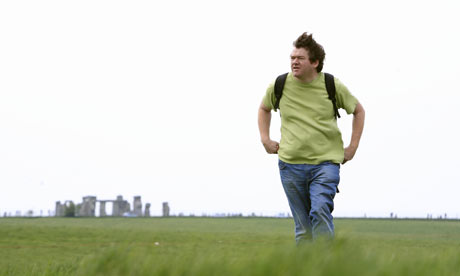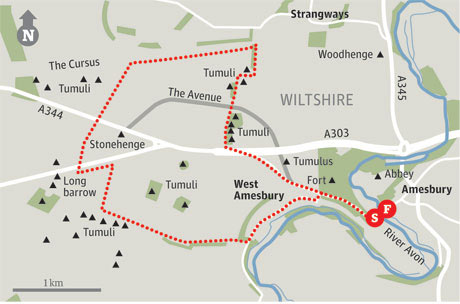Distance 4 miles (6.4km)
Classification Easy
Duration 2 hours
Begins Woodhenge car park
OS grid reference SU151434
Walk in a nutshell
An exploration of the parts of the Stonehenge world heritage site that most visitors miss out on. Starting at Woodhenge, the walk includes a visit to Durrington Walls, the Cuckoo Stone and the ancient burial mounds on King Barrow Ridge.
Why it's special
This is a trip back to 2500BC and beyond. While the Stonehenge stone circle was a place of burial in Neolithic times, Durrington Walls was where people actually lived and held feasts and rituals. The round barrows on King Barrow Ridge may also be around 4,500 years old.
Keep your eyes peeled for
Durrington Walls – the largest complete henge in Britain. The area outside the ditch and bank was once a settlement, perhaps containing hundreds of houses, making Durrington Walls potentially the largest village in north-west Europe at the time. Woodhenge stood nearby as an impressive timber circle surrounded by a bank and ditch.
Recover afterwards
In the restaurant of Amesbury's Antrobus Arms hotel , a 17th-century coaching inn where the Beatles stayed when shooting the film Help! on Salisbury Plain.
If it's tipping down
Head for the Salisbury & South Wiltshire Museum in the King's House, a Grade I-listed building opposite Salisbury Cathedral, to revel in exhibitions of local archaeological finds (and there's fun stuff for kids too).
How to get there
From Salisbury railway station, take the X5 or the Stonehenge tour bus to Amesbury, then the 16 to Woodhenge.
Step by step
1 From the car park go through the nearest gate and head away from Woodhenge through the north field. Walk downhill into Durrington Walls.
2 Next, turn left and walk to the corner of this field. Pass through gates either side of the road, heading towards a stone (the cuckoo stone). From here continue to the next gate.
3 You are now on the route of the old military railway between Amesbury and Larkhill; turn right and follow the path.
4 When you reach a crossroads and National Trust sign to King Barrow Ridge, turn left and follow the shaded bridleway.
5 At the junction turn right through a gate to continue along the ridge, crossing the Stonehenge Avenue on your way to a line of 200-year-old beech trees and a view of Stonehenge.
6 Continue forward to New King Barrows, a fine row of early bronze-age burial mounds, originally capped in white chalk so they would have been visible from a far distance. Retrace your steps back towards the junction then turn right to follow the bridleway.
7 Take a left turn through a gap in the hedge to join the old military railway. This leads back to the gate in the corner of the Cuckoo Stone field.
8 Head across the grassland to Woodhenge and back to Woodhenge car park.
More British Walks and full article by the Guardian http://www.guardian.co.uk/travel/2012/may/12/durrington-walls-wiltshire-walk?newsfeed=true
Local Guided Tours of the area: HisTOURies UK and SalisburyGuidedTours
Stonehenge Tour Guide




